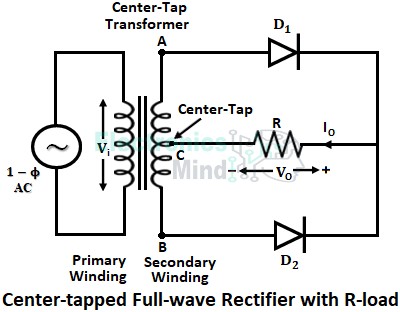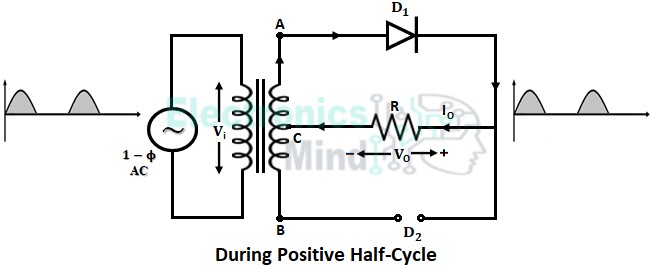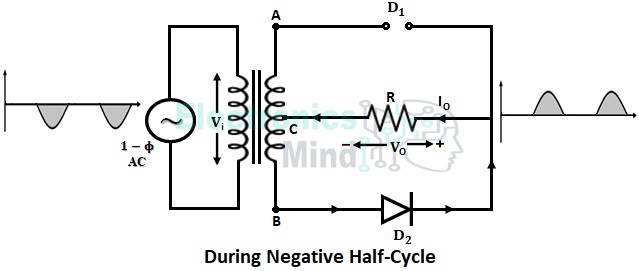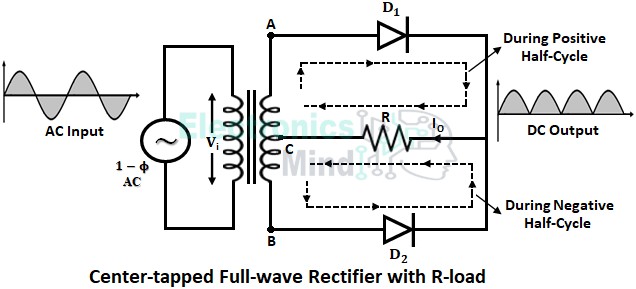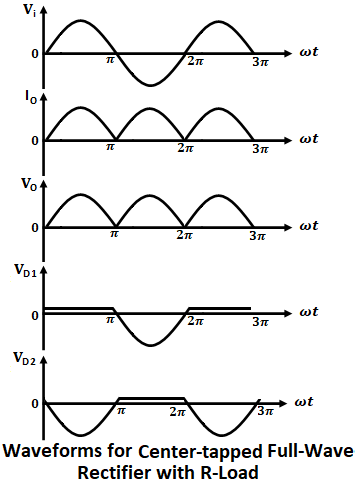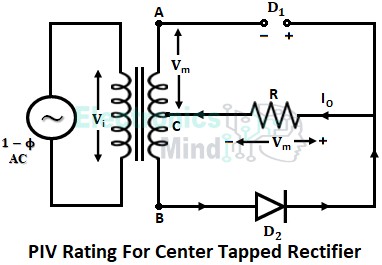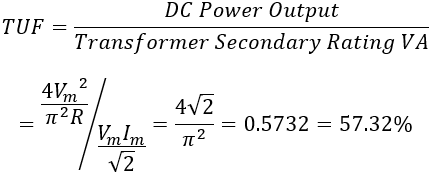Introduction:
The process of conversion of ac electrical power into dc power is called rectification. The circuit that converts ac signal into a dc signal (unidirectional signal) is called a rectifier or ac-to-dc converter. A rectifier uses semiconductor devices like a diode, thyristor, etc. for the conversion of ac power into dc power.
The output produced from a rectifier circuit is not pure dc but it contains some amount of ac component due to which output will be a pulsating dc. Thus the output of a rectifier needs further processing to get a pure and smooth dc supply. In general, rectifiers are divided into two types half-wave and full-wave rectifiers.
A half-wave rectifier is a simple and basic type of rectifier circuit in which only a half-cycle of ac supply is rectified. This type of rectifier circuit uses only one diode and converts only either the positive or negative half-cycle of ac supply into dc. Since only a half-cycle of ac supply is rectified, a half-wave rectifier has a high ripple, very low efficiency, and cannot produce smooth dc voltage.
The drawbacks of a half-wave rectifier can be overcome by a full-wave rectifier. A full-wave rectifier converts both positive and negative half-cycles of ac supply into dc. Thus the average dc output voltage of a full-wave rectifier is higher and contains fewer ripples than the half-wave rectifier.
A full-wave rectifier again has two types of circuit configurations, a center-tapped full-wave rectifier, and a bridge-type full-wave rectifier. In this article let us see the circuit diagram, operation, waveforms, and characteristics of a center-tapped full-wave rectifier.
Circuit Diagram of Center Tapped Full-Wave Rectifier:
A center-tapped full-wave rectifier circuit uses a center-tapped transformer and rectifying circuit which consists of two diodes for the conversion of ac power into dc power.
A center-tapped transformer is a type of transformer whose secondary winding is center-tapped i.e., an additional wire is connected exactly at the middle of the transformer’s secondary winding. The function of a center-tapped transformer is almost similar to a normal transformer that can increase or decrease the magnitude of the ac voltage.
But the only difference between a center-tapped and a normal transformer is that the center-tap present on the secondary winding divides the secondary winding into two individual halves due to which we can get two separate secondary voltages with a common connection. However, the two voltages produced from secondary winding are 180° out of phase with each other.
The ac supply source which is to be rectified is given to the primary winding of the center-tap transformer. Two diodes D1 and D2 are connected at two ends of the secondary winding and the other ends of two diodes are connected to the common load connected at the midpoint of the secondary winding as shown in the below circuit diagram.
The two diodes D1 and D2 act as two half-wave rectifiers in which one handles the positive half-cycle of ac input and the other handles the negative half-cycle of ac input. The voltage at the center tap on the secondary winding is zero and is considered the neutral point or ground point.
Working of Center Tapped Full Wave Rectifier:
When the ac power supply is turned ON, the input voltage Vi appears across terminals A and B. Now on the occurrence of the positive half-cycle of ac input, terminal ‘A’ on the secondary side of the center-tap transformer becomes positive and terminal ‘B’ on the secondary side of the center-tap transformer becomes negative.
Due to this, the diode D1 is forward-biased because its anode terminal is connected to the positive terminal and the cathode to the negative terminal. Whereas the diode D2 is reversed-biased because its anode gets connected to the negative terminal.
Thus during the positive half cycle of ac input, diode D1 allows current to flow through it and diode D2 blocks current. Therefore current starts flowing from terminal ‘A’, through diode D1 and reaches the load resistor. The current from the load resistor returns to the secondary winding through the center-tap terminal ‘C’ as shown below.
Once the positive half-cycle of ac input ends, the negative half-cycle starts where the polarity of ac supply gets reversed. Due to this terminal ‘A’ on the secondary side of the center-tap transformer becomes negative and terminal ‘B’ becomes positive.
This switches diode D1 into a non-conduction state (reverse bias) and diode D2 into a conduction state (forward bias). Thus during the negative half-cycle, diode D2 allows current to flow through it, and D1 blocks current. Therefore current starts flowing from terminal ‘B’, through diode D2, to the load resistor and returns through the center-tap terminal ‘C’ as shown below.
Therefore, during the positive half-cycle of ac input, diode D1 conducts and supplies power to load. Whereas during the negative half-cycle of ac input, diode D2 conducts and supplies power to load. There will be a very small voltage drop across two diodes during their conduction period which can be neglected.
In the above figure, we can see that the current enters the load from the same direction during both positive and negative half cycles. Hence both halves of the ac input will appear across the load in rectified form (i.e., in dc form).
Waveforms of Center Tapped Full Wave Rectifier:
The below shows the waveforms for the input voltage Vi, output current Io, output voltage Vo, and voltage drop across the diodes VD1 and VD2.
In the above waveforms from time period ωt = 0 to π, diode D1 conducts, and from time period ωt = π to 2π, diode D2 conducts. Since diode D2 is in OFF-state from ωt = 0 to π, input voltage appears across D2 from 0 to π. Similarly from ωt = π to 2π input voltage appears across the diode D1.
Since the load connected to the rectifier is of resistive type (R-load), both load current and load voltage will be in phase with each other i.e., waveforms of load voltage and current will be same. In the case of RL-load, the average output voltage will remain same as the R-load, but the output current waveform changes and it becomes non-sinusoidal (non-zero).
It can be seen that both the positive and negative half cycles of ac input waveforms appear across the load as a unidirectional output. However, the output produced at the load is not a pure dc but a pulsating dc output. The pulsating dc output is further processed using filters to obtain a pure dc supply.
Characteristics of Center-Tapped Full Wave Rectifier:
The characteristics of a center-tapped full-wave rectifier include rectifier efficiency, ripple factor, peak inverse voltage (PIV), dc output voltage, dc output current, RMS value of load current, RMS value of load voltage, and form factor.
DC Output Voltage:
The expression for the average value of output voltage is given by,
In the above equation, Vm is the maximum value of the transformer’s secondary voltage.
DC Output Current:
The expression for the average value of output current is given by,
RMS Value of Load Voltage (VRMS) :
The RMS value of voltage across the load is given by,
RMS Value of Load Current (IRMS):
The RMS value of current across the load is given by,
Efficiency :
The efficiency of a center-tapped rectifier is defined as the ratio of the dc power output to the ac power input.
Since both positive and negative half cycles of ac input are converted into dc. The efficiency of a full-wave rectifier is double the efficiency of a half-wave rectifier. The maximum efficiency of a center-tapped full-wave rectifier is 81.2%.
Ripple Factor :
The ripple factor is defined as the ratio of the RMS value of ac component to the average dc value. It is the measure of ac component in the dc component across the load.
The ripple factor gives the amount of ripple content or the degree of distortion present in the output dc signal of a rectifier. The ripple factor of a center-tapped full-wave rectifier is given by,
The above value indicates that in a center-tapped full wave rectifier 48% of the output dc will be ac component. If the value of the ripple factor is high the output of the rectifier will be pulsating dc and if the ripple is low the dc output will be smooth. Compared to a half-wave rectifier ripple is very less in a full-wave rectifier.
Peak Inverse Voltage (PIV):
The peak inverse voltage is the maximum voltage applied across the diode during its reverse bias condition (non-conducting state). It is the maximum reverse voltage a diode can withstand in the reverse bias condition before breakdown.
To calculate the PIV of a diode in a center-tapped full-wave rectifier, let us consider the below circuit in which diode D1 is in a non-conducting state and D2 is in conducting state.
Applying Kirchhoff’s voltage law, the peak inverse voltage across the diode D1 is given by,
Similarly, the PIV across the diode D2 when D1 is in conduction will be equal to 2Vm. Therefore, the peak inverse voltage (PIV) of the diode in a center-tapped full-wave rectifier is twice the peak voltage of the input sine wave.
Form Factor:
The form factor is defined as the ratio of the RMS value of the load current to the dc output. The form factor of a center-tapped full wave rectifier is given by,
Transformer Utilization Factor (TUF):
The transformer utilization factor tells how much a transformer is utilized in a circuit. The transformer utilization factor (TUF) of a rectifier is defined as the ratio of the dc power available to load to the VA rating of the transformer’s secondary winding. Therefore transformer utilization factor (TUF) of a center-tapped full-wave rectifier is,
Thus TUF of a center-tapped full-wave rectifier is 57.32% i.e., for 1kW of power input to the transformer, 573W power will be the output of the rectifier.
Difference Between Center-tapped and Bridge Rectifier:
| Parameter | Center-Tapped Rectifier | Bridge Rectifier |
|---|---|---|
| Number of Diodes | 2 | 4 |
| Center-tap Transformer | Required | Not required |
| Peak Inverse Voltage (PIV) | 2Vm | Vm |
| Maximum Efficiency | 81.2% | 81.2% |
| DC Output Current | 2Im/π | 2Im/π |
| DC Output Voltage | 2Vm/π | 2Vm/π |
| Ripple Frequency | 2fin | 2fin |
| Ripple Factor | 0.48 | 0.48 |
Advantages of Center-Tapped Full Wave Rectifier :
- The efficiency of a full-wave rectifier is twice that of a half-wave rectifier.
- Since both the positive and negative half cycles of ac input are rectified, the ripple factor is low compared to a half-wave rectifier.
- Low power loss compared to a half-wave rectifier.
- In a half-wave rectifier only either a positive or negative half cycle of ac input flows in transformer secondary winding, this unidirectional current can saturate transformer winding. This type of dc saturation is not present in center-tapped full-wave rectifiers.
Disadvantages of Center-Tapped Full Wave Rectifier :
- The transformer utility factor of a center-tapped rectifier is low because only half of the transformer’s secondary winding (upper half during the positive cycle and lower half during the negative cycle) is used to supply power to the load.
- High peak inverse voltage across the diode i.e., 2Vm, due to which diodes used in center-tapped rectifier should have a breakdown voltage twice that of diodes used in the half-wave rectifier.
- This type of rectifier circuit requires an additional center-tapped transformer which is expensive and occupies a large space.
- It is difficult to locate the middle point of the transformer secondary winding for center tapping.

